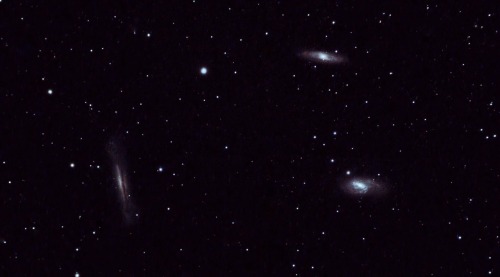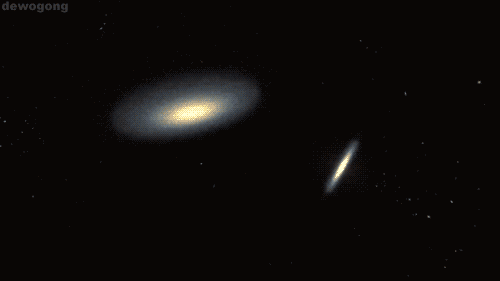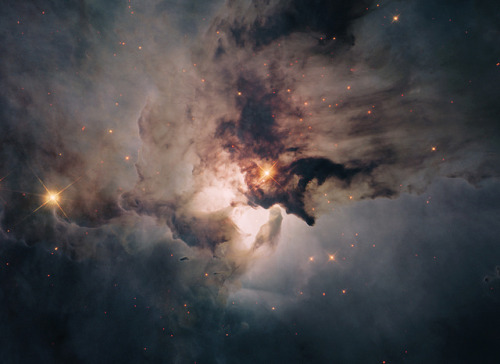Wow, This Is Spectacular.
Wow, this is spectacular.


Last night I shot The Leo Triplet. A small group of galaxies about 35 million light-years away in the constellation Leo. This galaxy group consists of the spiral galaxies M65, M66, and NGC 3628.
More Posts from Alitheastronomer and Others
That video is fascinating, I can't stop watching it!
Blizzard 2016 from Space
As an intense winter storm approaches the mid-Atlantic this weekend, our satellites watch from above. The storm is expected to produce a wade swath of more than 2 feet of snow in some areas.

The below supercomputer simulation crunched the data to provide a look at the flow of clouds from storm systems around the globe, including the developing blizzard across the eastern United States.
This storm won’t only have a snowy impact on the mid-Atlantic region, but will also cause severe weather in the Gulf Coast. Satellites observe extreme rainfall in the area.

Data from NASA-NOAA Suomi NPP satellite and NOAA’s GOES-East satellite are being used to create images and animation of the movement of this powerful storm. For updates, visit: http://www.nasa.gov/feature/goddard/2016/nasa-sees-major-winter-storm-headed-for-eastern-us

Make sure to follow us on Tumblr for your regular dose of space: http://nasa.tumblr.com

A wanderer dancing the dance of stars and space - the barred spiral galaxy NGC 1097
js

09/27/15



30 Doradus, located in the heart of the Tarantula nebula, is the brightest star-forming region in our galactic neighborhood. The nebula resides 170,000 light-years away in the Large Magellanic Cloud.
js

What’s Up for February 2016?
Five morning planets, Comet Catalina passes Polaris and icy Uranus and icy Vesta meet near Valentine’s Day.

February mornings feature Mercury, Venus, Saturn, Mars and Jupiter. The last time this five-planet dawn lineup happened was in 2005. The planets are easy to distinguish when you use the moon as your guide. Details on viewing HERE.
If you miss all five planets this month, you’ll be able to see them again in August’s sunset sky.

Last month, Comet Catalina’s curved dust tail and straight ion tail were visible in binoculars and telescopes near two galaxies that are close to the handle of the Big Dipper. Early this month, the comet nears Polaris, the North Star. It should be visible all month long for northern hemisphere observers.

There will be more opportunities to photograph Comet Catalina paired with other objects this month. It passes the faint spiral galaxy IC 342 and a pretty planetary nebula named NGC 1501 between Feb. 10 – 29. For binocular viewers, the magnitude 6 comet pairs up with a pretty string of stars, known as Kemble’s Cascade, on Feb. 24.

Finally, through binoculars, you should be able to pick out Vesta and Uranus near one another this month. You can use the moon as a guide on Feb. 12, and the cornerstone and the corner stars of Pegasus all month long.

For more information about What’s Up in the February sky, watch our monthly video HERE.
Make sure to follow us on Tumblr for your regular dose of space: http://nasa.tumblr.com

Milky way

Observatory in the path of an airport is rough on star trails haha
-
 claramys liked this · 3 years ago
claramys liked this · 3 years ago -
 devaneiosperigosos reblogged this · 3 years ago
devaneiosperigosos reblogged this · 3 years ago -
 devaneiosperigosos liked this · 3 years ago
devaneiosperigosos liked this · 3 years ago -
 nicole-queen liked this · 3 years ago
nicole-queen liked this · 3 years ago -
 thewildernessinyou reblogged this · 3 years ago
thewildernessinyou reblogged this · 3 years ago -
 srtasalvatore22 reblogged this · 3 years ago
srtasalvatore22 reblogged this · 3 years ago -
 srtasalvatore22 liked this · 3 years ago
srtasalvatore22 liked this · 3 years ago -
 adoreyoualways liked this · 4 years ago
adoreyoualways liked this · 4 years ago -
 black-is-the-new-colorful reblogged this · 4 years ago
black-is-the-new-colorful reblogged this · 4 years ago -
 tregende liked this · 4 years ago
tregende liked this · 4 years ago -
 gemalawashomestuck liked this · 4 years ago
gemalawashomestuck liked this · 4 years ago -
 indigointheflesh reblogged this · 5 years ago
indigointheflesh reblogged this · 5 years ago -
 indigointheflesh liked this · 5 years ago
indigointheflesh liked this · 5 years ago -
 piscessweetie reblogged this · 5 years ago
piscessweetie reblogged this · 5 years ago -
 hippiedelsole reblogged this · 5 years ago
hippiedelsole reblogged this · 5 years ago -
 illicitskies reblogged this · 5 years ago
illicitskies reblogged this · 5 years ago -
 psilocybin-dreams reblogged this · 5 years ago
psilocybin-dreams reblogged this · 5 years ago -
 shirley1518 liked this · 5 years ago
shirley1518 liked this · 5 years ago -
 thingzthingzthingz reblogged this · 5 years ago
thingzthingzthingz reblogged this · 5 years ago -
 kisstheloststars reblogged this · 5 years ago
kisstheloststars reblogged this · 5 years ago -
 apenas-esperar reblogged this · 5 years ago
apenas-esperar reblogged this · 5 years ago -
 brghtermoon reblogged this · 5 years ago
brghtermoon reblogged this · 5 years ago -
 itsalmostneverland liked this · 5 years ago
itsalmostneverland liked this · 5 years ago -
 restinpeacelullaby reblogged this · 5 years ago
restinpeacelullaby reblogged this · 5 years ago -
 mma--scorpion liked this · 5 years ago
mma--scorpion liked this · 5 years ago -
 philanderjc liked this · 5 years ago
philanderjc liked this · 5 years ago -
 blackstarbeneaththee liked this · 5 years ago
blackstarbeneaththee liked this · 5 years ago -
 cripple-cat liked this · 5 years ago
cripple-cat liked this · 5 years ago -
 cosmic-ricochet liked this · 5 years ago
cosmic-ricochet liked this · 5 years ago